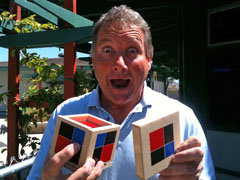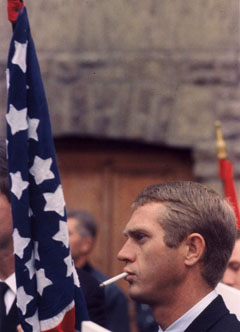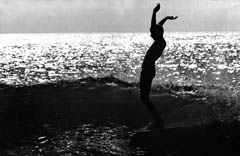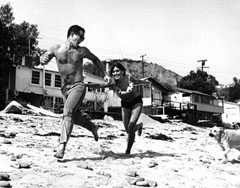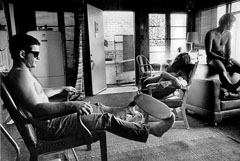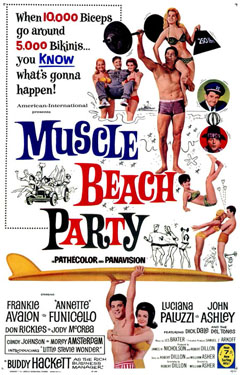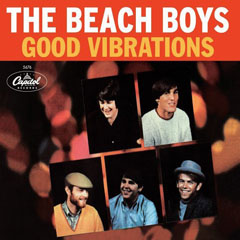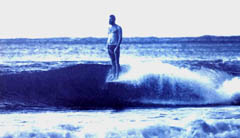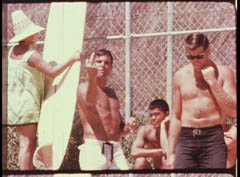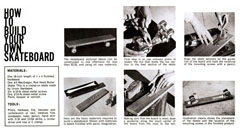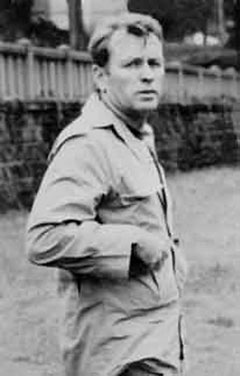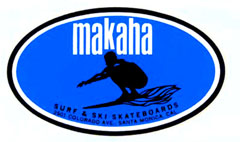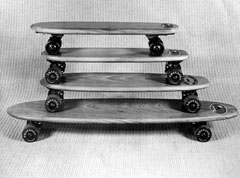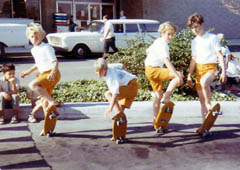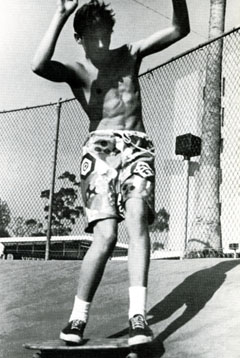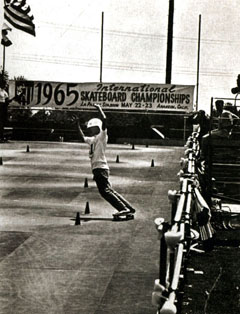|
Jim Fitzpatrick :
exclusive interview 2011
Introduction
Since reading an article in Michael Brooke’ book ("the concrete wave, " Warwick Publishing, 1999), I was waiting for an opportunity to cross one day, the path of Jim Fitzpatrick. The evocation of his trip to France during the summer of 1964, a few skateboards under his arms, seemed too good to not try to know a little more...
(And also in french here for those who appreciate Johnny Hallyday !)
Enjoy!
For starters
Where and when where you born?
I was born in San Diego, CA, February 10, 1948.
What was your parents’ job?
My father was a survivor of WWII; he fought in the Philippines and was captured twice by the Japanese forces and escaped both times. He was an artist, illustrator and writer, and eventually became a motion picture writer and director, and ultimately had his own production company in Hollywood, CA where he made documentary films.
Where is your family coming from? What are their ties to California?
My father was born in Oklahoma, where the Fitzpatricks at one time had enormous land holdings in the mid 1800s because of Irish immigration and the land rush.
My mother was born in San Diego, her parents had seen San Diego as a land of opportunity, and my grandfather scraped together a living, but during the Great Depression he had started his own business, a wholesale fruits and vegetables distributor and he secured the contract for supplying the US Navy, which became very lucrative for him. At one time he owned several real estate properties in the San Diego area, and he taught me a great deal about property management—do the work yourself and save money!
Do you still have family ties with Europe?
We’ve traveled to Ireland a few times over the past decade and we’ve managed to locate ancestral connections. There’s an interesting phenomena that’s been discussed recently about the whole migration in an excellent book, “Ancestral Links.” The point is that when the migration took place there was a psychological separation that took place, and those that stayed behind didn’t want to know about the success of those that left, and those that left were leaving Ireland for a reason, and they didn’t want to think about the old country and its problems. That seems to be the case in our family. The Fitzpatricks we’ve found in Ireland are more or less, “Yeah, that’s nice, so what?”
Do you have brothers or sisters?
Two sisters, younger than I, both school teachers, too. One is retired with her husband in central California, and the other lives in Colorado with her son who recently returned from a brief time in Iraq.
What were your childhood games?
I was passionate about traditional sports. I was going to be a professional baseball player, and a professional football player. One of my mother’s friends and co-worker was married to an LA Ram football player, and he occasionally visited our home and that was very cool. I played all traditional US games (soccer didn’t exist in the US then).
What was your education? Were your parents permissive or tight?
Typical all-American 1950s best public schools in the world education that more or less worked for me. I was bright and hyper-active and without drugs to monitor my behavior I was often times ‘in trouble’ or causing trouble. But it was fine. I loved school because my parents didn’t give a shit whether I succeeded, or not. Wait, that’s not true, I did well enough in school that they accepted it. They knew I could achieve more, but they had other things to attend to.
My upbringing was very liberal. My father once said to me, “Hey, you’re alive, and I’m alive, and there were times in the war when I knew I was going to die, and I didn’t, so as long as we’re alive we’re doing OK“.
Did you receive a religious education?
Not really. I went to a Sunday school with my sisters when we were 10, 7, and 5, but I soon discovered if I made sure my sisters were in their class then I could just bolt out the back door and go across the street to the park and play basketball, and eventually I would skateboard there. I had / have friends who were very religious. Catholic, Jewish, Bhuddists, and I’ve now studied religions for years.
Topanga Beach
Where do you live during your childhood?
We lived a block from the beach in Bird Rock, which is part of La Jolla and one of the nicest places in the world to live. It’s now very exclusive and expensive, in the 1950s our entire neighborhood was middle class families living on $5000/year, and almost every family had parents working at Convair Aeronautics building airplanes and rockets and missiles. My father’s work was to produce the documentary films of the rocket and missile launches, my mother was in the secretary pool.
Our house on Waverly Ave in Bird Rock was an All-American home. Safe and secure, but our street was the only one for miles that still had a dirt surface—during the 1950s it was still dirt, and when we moved to Malibu in 1960 it had only been paved for about 6 months.
That’s when my life took a major turn because we moved to a house on the beach; on the sand, at Topanga Beach in Malibu, CA.
How often did you move?
That one move was the only one that really mattered, when I was much younger we had lived in one other place, it was the move to Topanga Beach that changed everything.
You have experienced the emergence of the teenager in American society as an actor of a culture and economy. It was an historic moment. How have you experienced this phenomenon?
What a fucking amazing time to be alive is all I can say! My father’s early work in film production in the 1950s really put him and us in an unusual position—he befriended people in Hollywood, which is why we moved to Topanga Beach, and with surfing and skateboarding and movies and actors and actresses around the whole experience just exploded, for me, and for all of those around us.
An example would be the TAMI Show which took place across the street from my high-school. The Rolling Stones, the Beach Boys, and James Brown all on the same stage, and NONE of our teachers knew what was happening.
I had amazing opportunities. My dad began doing short films for the BBC’s Tops of the Pops television show featuring American rock and rollers, so we did shows with the Mamas and the Papas, and the Beach Boys, and Gene Pitney, Otis Redding, and many others…these are the people I was working with, and actors, too.
Elizabeth Taylor’s son was a friend, Lee Marvin was a friend of my father and his son a friend of mine. I played Little League baseball with John Fante’s son, Jimmy—we still play golf together today.
Bands. Music. Drugs. Sex. Vietnam. It was an amazing time, and I’m glad I was part of it.
This youth movement creates new idols in the music and film. What were your heroes?
James Bond. Ian Fleming put it together for me when I was 14. He might be responsible for my becoming interested in reading anything! But then the “Magnificent Seven” was a real experience for me. Style.
Later a great friend, she even lived with us for awhile, was Sharon Peckinpah, the oldest daughter of director, Sam Peckinpah. “The Wild Bunch.” Steve McQueen. Bullet.
Everything was so raw and so important. Bob Dylan. The Rolling Stones. Cream. The Who. When I was 12 I visited the set of the Ozzie and Harriet Show, starring all the Nelsons, including Ricky Nelson. Elvis. Ricky Nelson, Fabian, and then The Beatles and The Rolling Stones. Within 24 months the entire music scene changed, we went from the Kingston Trio to the Fab Four.
As a teenager, how did you experience the Kennedy assassination?
It was brutal. It changed everything. Truly. Hope and youth and someone to admire for not being old and not being from the generation older than my parents, and then he was gone, and with his death the promise of what he represented and presented.
Kennedy was shot and I was in the audience at our high school. The world’s fastest keyboard typist was performing on the stage. He could “play” songs on the keyboard while typing the lyrics to the song, he was insane, and 2000 kids are sitting there watching this guy bang away on the typewriter’s key board and the school’s vice principal walked out and announced, total deadpan, “The president of the United States has just be killed by an assassin in Dallas, TX.” Everyone freaked out and headed out of the auditorium.
(Good example of my weird world: Santa Monica High School’s vice principal was Porter I. Leach, the brother of Archibald Leach, the actor known as Cary Grant.)
Surfing
How and when did you get in touch with surfing?
Surfing came to me in 1958 when a friend, Danny Diven, bought his first surfboard (balsa wood) and began hauling it to the beach in the back of his mom’s car. I went along. She would drop us off at the beach and then pick us up later. Often times she wasn’t available so Danny and I would carry his board to the beach, a mile walk. Sometimes there were more than just the two of us. If you helped carry the board you got to ride a few waves.
At the time I had a canvas surf mat, which could be blown up with a high pressure pump at the gas station—the pumps used for car tires. The mat was so rigid we could get up on our knees, and even stand up for short distances.
What is the magnitude of the surfing phenomenon at that time the United States?
Surfing in 1958? Were there a dozen surfers? Of course there were, but “no one” surfed in 1958. Very few young people surfed because the boards were still very heavy; most surfers were young men, and many of them were not ‘mainstream’ guys…they were lifeguards or somehow involved with the beach, and surfing was part of what they did---fisherman, sailors, people living on or close to the beach.
Keep in mind that gasoline (petrol) cost $0.19 / gallon…life was inexpensive, but the surfboards were made of wood and it took a ‘real’ man to carry them to the beach.
At that time, what is the segment of the population that practice surfing?
Very very limited.
Is surfing going hand in hand with a certain marginality in society? The bohemian side, influenced by the Beat Generation?
Right, many early surfers were living on the “fringe.” They didn’t have regular jobs, they were hanging out at the beach and making ends meet, thus their lifestyle was simple, but filled with blue skies, good waves, and as a result they were tanned, handsome, physically fit, and often times very attractive to young women. Life was good.
How did you feel the onset of Surf Music in the early 60's? Is it far from the culture of the (real) surfers?
Surf Music was stupidly appropriate. It was silly, and it contrasted completely with what the Beatles and Rolling Stones were putting out, but the Beach Boys created something that went beyond the beach.
You often mentionned the Beach Boys. Did you ever met Dennis Wilson, the only Beach Boys that was a surfer ?
That's funny, yes I did meet the Beach Boys and worked with them on several different levels. In 1963 my father started working on "Tops of the Pops" which was an early rock and roll show. My father's responsibility was to provide film content of the British chart's number one American rock and roller—which ever performer or band was the most popular in England that week was meant to be captured by his crew and then sent air-express for broadcast on the BBC. The whole experience eventually involved four of us working with my father, including George Van Noy (who I would later work with on a Roger Corman feature movie). In the early 60s we worked with Diana Ross and The Supremes, Len Barry, Otis Redding, and eventually the Beach Boys.
"Good Vibrations" was one of the Beach Boy songs we filmed on location in Santa Barbara. We spent two days surfing, and there was a memorable moment when driving from Santa Barbara to Hollister Ranch with Dennis riding a motorcycle. As we passed alongside him he stood on the seat leaning over the to handle bars, and when he released the throttle the bike began to slow he managed to keep his balance and stand upright on the bike's seat! Essentially surfing the motorcycle. He was a thrill seeker, which was his undoing in the end. Broadcast weeks late on the BBC the film, including the edited version and out-takes, was later taken by a producer from the film vaults where they were stored in Hollywood. He was producing a television special on the Beach Boys and found out about my father's footage. I'm still, 20 years later, trying to get those films back from him!
Last year I was on a flight from Washington, DC, and noticed Brian Wilson sitting in first class. I spoke with has travel companion, an attorney, and when we deplaned the attorney introduced me. Brian, for a moment, was very clear and every bit a gentleman as I described our shared experience from the 1960s, and then as other people gathered behind us he reassumed a different posture and walked off with the attorney.
I have the feeling i can ask you about anything or anybody and you get the answer ! I want touch your limits ! The Pope ? Elvis ? Marilyn ?
Mother Teresa. She and I were in the hospital together. I had gone to Scripps Hosptial in La Jolla, CA with a terrible sinus infection from the ocean, and while waiting behind a curtain for the doctor I heard the sound of a helicopter landing outside. Suddenly every medical person in the building was rushing outside, and then there was incredible scurrying down the hallway and when I pushed back the curtain there was Mother Teresa, on a gurney rolling by, her prominent nose directed toward the ceiling with her signature 'habit' draped about her.
The Pope we saw in Rome in April, he was driving by in the Pope-mobile.
Elvis. We had a friend in high school who was a dedicated Elvis groupy who actually spent time with him at the Ambassador Hotel, but she was never able to get us to be able to meet up with him. I was in Memphis during Dead Elvis Week 15 years ago, it was incredible! There were Elvis imitators everywhere! My son and I interviewed as many as we could and I wrote a funny piece for a magazine.
Marilyn. President Kennedy was at the beach house of Peter Lawford in Santa Monica, that's where he met up with her. His being there was supposed to be a secret, but we all found out because Lawford lived next door to Davey and Steve Hilton's parents house on the beach in Santa Monica. There were Life Magazine photographs published with President Kennedy on the beach, but I didn't make it into those photos.
Do you met Neil Young in Topanga when he was recording “After the gold rush“ in his basement studio ?
No Neil Young. Despite my admiration for his music it wasn't until we lived in Santa Barbara, when David Crosby's daughter was in our school, that I ended up close to crossing paths with Neil Young. Crosby did a benefit concert for our school with his friend, Jackson Brown. A great night of music, and a gréât benefit to the school.
OK, let’s return with the sound of the Ocean…
On what board did you start surfing? Was it a board you had bought? Made? Re-Shaped?
In 1960 my family moved to Malibu’s Topanga Beach into our house on the sand at a right point break that became “mine,” for several years. My first surfboard was a “Lyman” and it was perfect for me although it was a terrible board.
Perfect because it was foam, lightweight and had an incredible rocker nose to tail. It was 8’, which made it ‘small,’ and I was small and skinny and lightweight, so it was just what I needed.
Do smaller boards for young surfers, existed in the 60s?
The only small boards were those that people cut down, or random boards like my “Lyman.” There were so few young people surfing that the board makers didn’t have a market for smaller surfers.
Would you say the boards evolved more during the 60’-70’s or now?
Funny, because the evolution of board shapes has now taken us all the way back to small little planks without fins! Now shapes are far more sophisticated and technical, and with machines and moulds board shapes can be standardized as never before, and there are mover varieties of shapes for different waves and conditions, but it’s always still about surfing, right. Riding the wave.
In the 60s everyone seemed to have one board. There were surfers from Hawaii who came to Topanga Beach and they brought with them modified ‘guns’ that were almost unrideable in small surf. I had one board that I rode in every condition or every size wave, whereas today ‘quivers’ are what most surfers have, right?
Have you ever shaped a board? Give particulars to a shaper so you can have your own customs board?
Yes, before I went to school to attend the Montessori institute in Italy in 1971 I worked for Dewey Weber Surfboards. I was the glosser; glossing boards shaped by Harold Iggy and glassed by Tak Hasekawa. I shaped two boards for myself; one a longboard and one short. They were stolen from my house while I lived in Italy. I’ve shaped boards since, and my longtime friend, Craig Angell, who has been shaping boards for more than 20 years, spend most of our time together talking about boards, shapes, and what to do about the next board he makes.
Who did you surf with?
In the early 1960s I surfed with Bill Cleary on a regular basis. As editor of Surf Guide Magazine and later Surfer Magazine, Bill attracted lots of other “known” surfers who would end up in the magazines. But there were other surfers at Topanga Beach, too; Wes Armand, Mike Gaughan, Norm Ollestad, and then our younger generation, too: Woody Woodward, Joey Saenz, Eddie Saenz, Nick Saenz, and Felix and Juan and Michael Saenz. Bruce Bernstein and Nick Stansbury.
Who are the surfers that you admired at that time?
Bob Cooper was an early influence. Mike Gaughan, and Mike Waco had an incredible style that really captured me. He was tall and skinny, and I had the skinny thing down too, and then there were all the photographs. Mickey Munoz. Phil Edwards.
Teenager, you surfed with Mickey Dora. How was he? Was it intimidating to surf with such a character? What inspiration did you draw from him?
My relationship with Miki was very special. For 10 years he came to my house to go surfing. Not too many people had that relationship with him. He used to sit and drink tea with my mom. Seriously. He could be a very charming gentleman, and he knew how to succeed with different situations at several different levels.
We always had a great friendship and I always was glad to see him. After my wife and I were married in 1969 we left Hawaii and traveled in Europe for three months. We drove from Portugal to Biarritz so I could show her where I had been in 1964. We were staying in the same hotel (Bernache?) and when I needed to use the toilet I went to the end of the hall and opened the door and there on the toilet sat Miki!
“Hey!” I said, “Miki, what the fuck?” He says, “Hey, man, how are you? Could you close the door and I’ll talk to you later…”
We spent three days together, but INTERPOL was looking for American drug smugglers, and we left. Miki went to Spain and we went to Paris and on to London.
Did you have to impose you on the spot as today or to defend a territory? In short, was localism already in the water?
Localism is very intense in Santa Barbara, now, and it always has been. Growing up at Topanga Beach we guarded our waves. We sabotaged cars and surfers who snuck into our private beach. When the surf was poor we didn’t care; we would let surfers come down to the beach and then go looking for the treasures in their parked cars. When the surf was good we’d be all over “our” waves, and typically there were enough of us to protect and defend each other.
For nearly ten years I believed the waves at Topanga Beach were mine. I believed each wave was mine to decide if I would ride it, or not, and most of the time I rode the wave I wanted. For a skinny kid I was a good surfer, and could arguably believe I was the best in the water—I was really obnoxious, but my surfing ability often times dictated I could walk the walk in addition to talking the talk!
Now? I’m OLD, and if I can catch a wave then you’d better get out of my way. I do not care if you take off in front of me, but DO NOT make me slow down, because I won’t wait for you. Miki helped me with that. Today, if I catch it first, it’s my wave, so get the hell out of my way!
The first wave of skateboarding
How did you get in touch with skateboarding?
We made them ourselves. It was something to do, and then it was THE thing to do. I loved it because NOBODY else was doing it.
What’s your first board?
Hand made by me, a steel-wheeled roller skate nailed to a board.
It was in what year?
1957.
Who is George P. Wlson? A surfer? An engineer?
George P. Wilson “Buster” was a friend of my father; they went to high school together, and they ‘surfed’ together at the beaches in San Diego…they “body surfed,” I don’t think I ever saw them even consider a surfboard.
Buster had 4 or 5 Jaguar automobiles, and at least one or two was always being rebuilt in his garage. He had high-end bicycles, too, and rifles, and hunting bows. He was always building or remaking something, and one afternoon he said, “Hey, quit bothering me, make these!” and he showed us (his sons and I) how to make a skateboard. “We used to make these when we were kids, here, this is how you do it!”
And that was the beginning for me.
Do you remember what word do you use to call a skateboard before they are called sidewalk surfing, and then skateboards?
We always called them skateboards. I lived on the other side of San Diego from the Wilsons; they lived in Point Loma, and we lived in Bird Rock, close to La Jolla, about 20 miles away. I took my first skateboard from Point Loma back to Bird Rock and went over to Danny Diven’s house and announced, “Look at this!”
At what moment did the name « skateboard » won over « sidewalk surfing » and under what circumstances ?
Sidewalk Surfing was never a phrase or term used by us, it was a Jan and Dean (Beach Boy-like) lyric for their song, and it was stupid then, and stupid now. Plus, I was skateboarding before I was surfing (1957 was my first skateboard; one year before I stood up on a surfboard in 1958), so I was a skateboarder before I was a surfer.
Do you skate in a particular place? Parking? A slope?
In 1957 we skated on sidewalks and at Bird Rock Elementary School. Eventually I skateboarded in parking lots, too, including the parking lot at La Jolla Shores beach, because they built a new parking lot along the beach that was enormous, and I could go surfing with my mat and then skateboard in the parking lot.
What are the first tricks that you could do with a skateboard?
Steel wheels! STAND UP! STAY STANDING! STILL STANDING! That was about it. All of my boards had the skates on the nose and on the tail, there was no leverage for turns. It was a straightforward world. Fast was an option.
You lived not only the revolution of urethane wheels but also the passage of the wheels of steel wheels in clay. Tell us how it was to go from steel to clay?
Clay wheels are what were on the Makaha skateboard given to me by Bill Cleary. Not only were the wheels more forgiving, but there was a sort of ‘truck’ that had a bit of cushion to it, and it was actually possible to turn by leaning in one direction or the other.
There was no turning a steel-wheeled board. None whatsoever. The first time on the Makaha board was astounding, because it was possible, instantly, to turn. It really was sidewalk surfing in that moment because I could turn and turn and turn, within minutes I was carving turns down the Topanga Beach Road.
It was a huge transition.
What did you get from steel to clay and clay to urethane? What new Tricks could you do with each transition?
When I returned from Europe in 1964 I had two Makaha skateboards, but I also became very involved with girls and with football and baseball at my highschool. I still surfed nearly every day, but skateboarding was beginning to fade for me.
Meanwhile, down the road at Woody Woodward’s house, he and Torger Johnson, and Danny Bearer, and John Fries and Joey Saenz were skateboarding almost every day. I was in high school and could drive my VW Bus, and they were in junior high school and skateboarded all the time.
By the time I was getting ready to go to Africa in 1965 they were getting ready to enter the USA Skateboarding championships, which Woody won as a 12 year-old, and I didn’t even know there was a contest…I was working in Hollywood, earning as much as $150/day, and had little use for skateboarding. I left for Africa in June and didn’t return until September, and then it was off to college for me.
All of that was happening on clay wheels. Woody. Bruce Logan. By 1968 my father died suddenly, and I was running his company, and then in 1969 we were married, and my life without skateboarding was developing quickly.
In 1975 we moved to Santa Barbara after starting the school here, and we lived on Humphrey Road by Miramar Beach (Jack Johnson lives there now). We had two children and we were living on welfare, and one day the kid next door skateboarded by on a SIMS with Cadillacs. I thought, “What the hell? Why is that so quiet?” “Hey, can I try your board?” I asked.
Wow. That was my first urethane experience and I could not believe what was happening to me. A couple of months later the boy’s father came over and asked for the board back. “Hey, man, have you seen my kid’s skateboard?”
Is Skateboarding a phenomenon in California then? Only in California? Would you say skateboarding is an American sport or a Southern Californian sport?
I never felt like skateboarding was a phenomenal thing for others, it was phenomenal for me; it separated me from others, and made me feel special, but it was always more the sense that others were asking, “How in the hell do you do that? Hey, Honey, come look at what this kid is doing! Look at that, will ya!!!”
It the beginning it may have been a California thing, but by the early 60s there skateboarders in Texas and in Florida, New Jersey…any where that surfing was starting up there were skateboarders beginning to put it together, too.
Makaha
How do you meet Larry Stevenson?
Larry was a very busy guy, and he started a surfing magazine, “Surf Guide.” It was in early competition with Surfer Magazine developed by John Severson.
Larry hired Bill Cleary to become editor of Surf Guide. Bill was a UCLA literature graduate, and he was determined to outdo Severson. It became very competitive between the two magazines. Severson was a good friend of Hobie Alter’s and Hobie’s surfboards and skateboards would be become the arch rivals of the early 1960s. Makaha vs. Hobie; “Surf Guide Magazine” vs. Surfer Magazine.
Do you participate in the development of the first boards he sells in 1963?
Only in the sense that we were all coming up with ideas for how to sell more boards. I was 15 at the time, and my real job that entitled me to more boards was to sweep the floor and help out in the factory.
How is the skate team Makaha set up?
Originally there wasn’t a team. For six months I was the team. There were a handful of boards and I was skating them…it was very slow in development, and then it sort of exploded. How to find good skateboarders was the challenge, and the way to do it was to go to schools and other beach towns and start skateboarding, and it just happened from there.
Dave Rochlen, Jr., briefly, and then Bob Feigel, who also lived at Topanga Beach, were “Commander Makaha,” and would drive us to different locations, and then there was the idea of contacting other businesses and doing demos for them and then we were doing store openings and any event that a crowd. Feigel is important because he was a local surfer and writer who had a column in Surf Guide Magazine. His column was devoted to parables, and one of parables poked serious fun and John Severson and Surfer Magazine to such an extent that a lawsuit was actually filed by Severson.
Who were the other skaters of the team?
Greg Carroll and Bruce Logan were from ‘South Bay’ (the locale where LAX is now), and then George Trafton, John Fries, Woody Woodward, Danny Bearer, and for brief while Davey and Steve Hilton, were all part of the team. In 1964 we all did a demo on the Greek Theater stage at Santa Monica High School where I went to school. That was the last demo I did…they were all in junior high, and I was in high school and just spending less time skateboarding (and more time with girls).
Do you know you all of them before joining the team?
I never really knew Bruce or Greg, and didn’t actually meet Bruce until last year when I was the MC for his induction into the Skateboarding Hall of Fame. We were both really happy to finally have the chance to meet each other!
Parallel to skate, you're already in a surf team?
Yes, I was on a few different surf teams; first Con Surfboards (Con Colburn), then Dave Sweet Surfboards for a few years, and finishing on Hobie’s team, which was the most prestigious, but I should have just stayed on the Sweet team. Hobie’s team in our area was managed by Dave Rochlen, Jr., and for awhile he was the Makaha Skateboards team manager. But Hobie wisely had him steal the Hiltons from the Makaha team for the Hobie Skateboard team, and things became very complicated at that stage.
In a french magazine named “Skatin’“(1978) Larry Stevenson talk about a competition in december 1963 : the"Makaha National Skateboard Championships". Could you tell us about the contest? Where, how, who, what happened?
I don’t know…are you sure of the date. I wasn’t involved. Weird.
Did you have a specialty? A trick that you were the only one to do?
“Tricks” were happening so fast, that if you could do something no one else could do, everyone else would immediately copy it and try it until they could do it, too!
Did you feel that there was a click in American society in relation to the skate? What made skateboarding an American sport? The article in "Life" magazine in 1965? The film "Skatedater" in 1965?
It was “American” because we had the skateboards and the surfing culture to go along with it; which is why we had so much fun in Biarritz in when I showed up in 1964…I had 12 Makaha Skateboards with me and there were five or six of us who skateboarded EVERYWHERE. I left four of those boards behind…Jean Marie and Francois Lartigau; Joel Rosnay? I’m not sure who ended up with the boards I left behind. That would be a story, right, to track down those boards!
That was a marvelous expedition, I was an “ambassador” of southern California culture.
“Skater Dater” was filmed by Michael Murphy, my father’s cameraman, and many years later this became a discussion point between Murphy and myself, because Murphy realized, after my father had died, that if my father had simply shot film of my life and what and how surfing and skateboarding developed in and around me, that it would have been an incredible documentary. But…but my father was busy living his life with his family and his children, and surfing and skateboarding were just something I did. He, nor I, never considered the ‘historical’ aspects of what we were doing.
Was it even considered as a sport at that time? Was skateboarding even considered serious or just a game for kids?
Not a sport. It wasn’t recognized as anything. It was skateboarding, and that was enough for us! Nobody really took notice. Because no one else, especially older teenagers or young adults, had any interest there was no interest. Larry Stevenson was one of the few “adults” who actually good visualize skateboarding’s future. He knew, in the earliest days, that eventually skateboarding would be a world-wide phenomenon.
The boom of the 60s
A famous picture of you is often reproduced on an inclined plane, in shorts, a fence at the bottom of the image. Do you remember where it was?
The photograph was taken in 1964 at Brentwood Elementary School on San Vicente Blvd. in West Los Angeles. We would skate there as much as we could.
It’s interesting, 10 years later, as a young father my wife and I returned to Santa Monica and we taught school in our classroom at that school. At that time, in 1975, I don’t remember ever seeing anyone skateboard at the school.
Only last year were the embankments totally resurfaced with new asphalt; for years the surface was cracked and filled with weeds—the school didn’t care and was glad that skateboarders couldn’t use the banks.
Did you have to get over the walls to skate this kind of place?
Nope, at the time in 1960s the schools were wide open. There were four other schools with different terrain that we would visit. Feigel or Jim Ganzer (later he developed Jimmy-Z) would drive us to Bellagio School, or Paul Revere Junior High School, or Palisades High School—they all had embankments of the different heights and lengths. Paul Revere may have been the favorite…Bellagio was step and gnarly like Waimea Bay or some big wave spot.
Is the income sufficient to live just from skateboarding? How were you paid?
I wasn’t paid anything, but I never bought a skateboard. I had my team jacket, and when I went to Europe in a convoluted way Makaha helped pay for my trip. There were demos and trips, and we didn’t pay for the trips, so our travel was paid and hotels—the Makaha Team went to Hawaii just to show the Hiltons and the Hobie Team that they could go to Hawaii, too. Jim Ganzer was Commander Makaha for that trip, which I wasn’t part of. But there was no “salary” or appearance fees paid for those events.
What was the best skater of this generation for you?
Well, in the beginning it was me (hahahaha), but when I came back from Europe in 1964 I realized that Woody and Frie, Torger, and Danny Bearer, and Trafton, had all sort of left me behind. They were amazing in what they were able to do, and do fast…I sort of hung up my skateboard as I realized they’d left me behind!
Actually, when I returned from Europe I had just a few days before football practice started, and our summer practices were intense “Two-A-Days” with sessions in the morning and sessions in the afternoon. If you wanted to play football you had to survive these practices which concluded right at the beginning of the school year.
Have you tried to skate the empty swimming pools in the 60s? Had anybody tried to skate pools in the 60’s or did riding pools only started later, in the 70’s with that famous drought in L.A.?
In 1964, after I had been in Europe we went to Rand Carter’s home in Pacific Palisades and skated in his pool around the last puddle of water in the deep end. I think Woody was there, and maybe Trafton; Rand knew Danny Bearer and Jim Ganzer, so they would have been there. But all that was accomplished was pushing toward the deep end’s wall and then trying to ride the wall above the water. I don’t remember making it. I think I bailed out each time because of lack of speed, and my board was soaked and the bearings came out; it was a disaster, but I think someone else made it all the way around. Maybe Rand, maybe Danny; I don’t remember anyone else doing it again. I know Mr. Carter was pissed off. He was one of my junior high school teachers for mechanical drawing and drafting, and he was a no nonsense guy who was pissed off when he found out we’d been messing with his pool’s surface.
At that time, do you skate barefoot or with shoes?
Early on it was barefoot all the time. But my feet were ragged! Always bloody messes. Shoes were a problem, but lack of traction was a bigger problem. I went to a hardware store where they sold something that was similar to what would later become grip tape—they had strips of rubberized material with sand permeated inside that was used to be put on the edges of stairs, and I glued that on my board.
Did you have a particular model that you wore to skate?
Jack Purcell. They were made for sailing, really great sole with lots of traction. I’m wearing a pair of Purcells in that photograph.
Do you remember the appearance of the first shoe designed for skateboarding in 1965, Randy "720"? Did you test or wear it?
Nope. Never saw it.
In the 60s, there are dozens of manufacturers. What made the difference between a good and a bad product at that time?
For me a good product was one that someone would give me. I didn’t buy anything that had to do with skateboarding or surfing. My trunks, my t-shirts, anything that I had regarding surfing and skateboarding was given to me—I earned it!
In 1964, L. Stevenson said he already had developed polyurethane wheels and in 1965, Hobie Alter says he was approached by a company "Amercan Latex" to market urethane wheels. Do you know something about that or is it just hype?
Have you had the opportunity to test this type of product at that time?
No. I was too busy “doing” to think about products or what I might be involved with…things would have been different had I paid more attention, but I didn’t care. I just was busy with surfing, with skateboarding, and then, girls. Turns out I liked being with girls more than anything else!
CONTINUES ON PART
2
|

